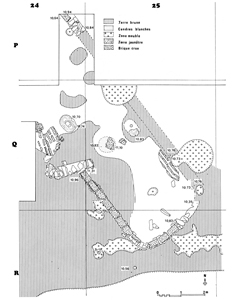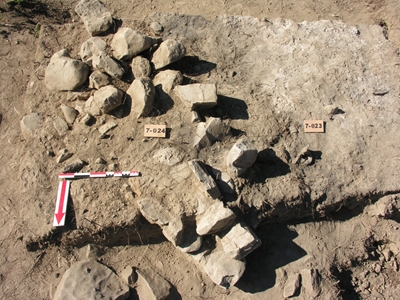BRONZE AGE: HOUSES
The houses of the late bronze Age
 |
The only building whose ground plan is known, at least in part, is the one excavated by J. Deshayes in sector Α2. It is roughly rectangular; only one narrow side was unearthed that is very slightly curved. Its width is approximately 4m, whereas its length could be more than 10 m, if we admit that part of a wall found further north of its eastern wall actually belongs to the same building. The entrance has not been found. Two successive floors were identified. The earliest, found underneath a burned destruction layer, has two unusual clay structures. The second does not seem to contain any similar constructions, but it was also covered by a layer of ash. This impressive building has no direct parallels in the region, although buildings with curved walls are known from several other sites (Kastri in Thasos, Kastanas, Vardina). |  |
Walls were built with stone foundations and a superstructure made of mud bricks that were partially preserved by the fire. The same construction technique is found in most other walls from the Late Bronze Age layers in Dikili Tash, thus revealing a well-established tradition. Some of them preserve only the stone foundation, but there is no evidence of the use of other techniques.
Very little is known about the fixed domestic structures of this period: no ovens, hearths, or benches have been discovered, apart from the two unusual structures of the “Deshayes’ building”. Similarly, our understanding of mobile house equipment is quite poor: very few objects were found in situ, and when this was the case, it was not clear whether we were inside or outside of a room. So far, however, only one building’s interior has been excavated. Future fieldwork will definitely tell us more about the organization of living space during this period.

